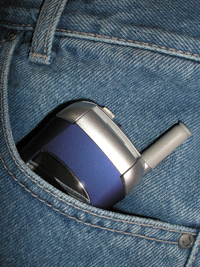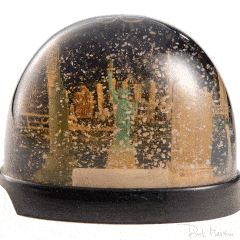All-or-Nothing Mentality
When I start a new project, my recurring wish is to have a huge block of time where I am completely free of distractions so I can buckle down, focus on the project and emerge a day or two later with a beautiful finished product. I know, I should keep dreaming because unless I live in a bubble, this will never happen. The risk of having this outlook is that it becomes challenging to even start what I know will be a lot of work in a block of time that I know won’t be nearly enough. It’s stressful and often by the time I get my act together, figure out where I left off and collect what I need to do the work, I’m just about out of time.Changing the Strategy
What I’ve started doing more recently is using small time pockets we have all during the day that are often underutilized. You know, the half hour in the morning after you do your initial email/voicemail/social media checks and before you dive into work; the 15 minutes after your reminder alarm goes off but before a meeting starts; the chunk of time over the weekend when you’re not officially working, but you jump on your computer while you wait for a friend to arrive. Must-Dos for Making Time Pockets Productive
Must-Dos for Making Time Pockets Productive
These organic time pockets are a perfect way to get something small accomplished that will help move you forward. And these chunks of time can really add up. But you need to have some things in place in order to use small pockets of time effectively.
Break Down Tasks
One of the most important things you can do is micro-task. That is, take every task on your list and break in down into tiny, measurable actions. For example, instead of “redesign portfolio,” you may have:- Make a list of client sites to include in portfolio
- Decide what format your portfolio will be
- Take screenshots/videos/etc. of selected sites
- And so on…
Prepare What You Need
When you create your task list, start to gather all of the materials, files, links and other information you anticipate needing as you work through the list. It’s also important to have a standard way to organize this information so it’s easy to find when you need it. The standard organization process is also great for collecting relevant information that you come across while working on other projects.Document Along the Way
When necessary, take a minute or two at the end of your time pocket to jot down a note about where you left off and what you need to do next. This will help you pick up back up with less fumbling around.Schedule in Advance
Some time pockets are regulars; they usually happen every day around the same time. Pick a few regular time pockets each week for your ongoing project and put it on the schedule. It will become a regular habit and you’ll get more accomplished than you anticipated by the end of each week.Go Mobile
If you have a smartphone and can do some work on the go, why not bring it with you? I have taken advantage of many time pockets by being able to work while waiting for an appointment, riding in the car (as a passenger), and when I’m otherwise away from my computer. Of course, time pockets are also great for taking breaks, so split them up between downtime and focused work time for balanced productivity. Do you effectively use time pockets for work? What tips can you share? Image credit: DartVaderFrequently Asked Questions (FAQs) on Time Pockets for Productivity
What are time pockets and how can they boost productivity?
Time pockets are small, often overlooked periods of time in our daily routines that can be utilized for productive tasks. These could be waiting times, commuting times, or even short breaks. By identifying and using these time pockets, you can significantly boost your productivity. Instead of wasting these moments, you can use them to complete small tasks, plan your day, or even learn something new.
How can I identify my time pockets?
Identifying your time pockets requires a careful analysis of your daily routine. Look for periods where you’re not actively engaged in a task, such as waiting for a meeting to start, commuting, or even while having your morning coffee. These are potential time pockets that you can utilize for productivity.
Can time pockets be used for learning?
Absolutely! Time pockets are excellent for self-improvement and learning. You can listen to a podcast, read a chapter of a book, or even take an online course during these periods. The key is to choose activities that fit the length of your time pocket and can be easily started and stopped.
How can I manage distractions during my time pockets?
Managing distractions is crucial for utilizing time pockets effectively. You can use techniques like turning off notifications, using noise-cancelling headphones, or choosing a quiet environment to work in. It’s also important to choose tasks that require a level of concentration suitable for the environment you’re in.
Can time pockets be used for relaxation?
Yes, time pockets can also be used for relaxation and self-care. It’s important to balance productivity with relaxation to prevent burnout. You can use your time pockets to meditate, do some light exercise, or simply enjoy a cup of tea.
How can I make the most of my commuting time?
Commuting time is a common time pocket that can be utilized effectively. You can listen to audiobooks, plan your day, or even catch up on emails during this time. If you’re driving, consider using voice-activated apps to ensure safety.
Can time pockets help in achieving long-term goals?
Time pockets can certainly contribute to achieving long-term goals. By consistently using these small periods of time, you can make significant progress towards your goals. It’s all about consistent, incremental progress.
How can I track my productivity in time pockets?
You can use productivity apps or simply keep a journal to track your productivity in time pockets. This can help you identify which activities work best for you and adjust your strategy accordingly.
Can time pockets be used for creative tasks?
Yes, time pockets can be used for creative tasks. However, it’s important to choose tasks that can be easily started and stopped, as time pockets are often short periods of time.
How can I incorporate time pockets into my daily routine?
Incorporating time pockets into your daily routine requires planning and discipline. Start by identifying potential time pockets in your day, then decide on the tasks you want to complete during these periods. It’s also important to be flexible and adjust your plan as needed.
Alyssa Gregory is a digital and content marketer, small business consultant, and the founder of the Small Business Bonfire — a social, educational and collaborative community for entrepreneurs.






